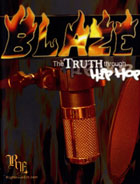
Blaze: The Truth Through Hip Hop 2008, 2010
Distributed by Third World Newsreel, 545 Eighth Avenue, 10th Floor, New York, NY 10018; 212-947-9277
Produced by Maurice Lynch and Mahogany Jones
Directed by Maurice Lynch and Mahogany Jones
DVD, color, 91 min.
High School - General Adult
Music, Religious Studies
Date Entered: 07/11/2011
Reviewed by Felice Neals, New York, NYBlaze: The Truth Through Hip Hop begins with a nod to Gospel music and its crucial place in the music world. Various music enthusiasts - presumably musicians and/or active players in the music industry (their names and affiliations are not specified) – are interviewed and share their personal connection to hip hop, its relevance to the music scene and its appeal to a wide-spread and diverse audience.
It is not clear that the main focus of the film is Christian-themed hip-hop until later when religion and God are referenced by those interviewed.
The use of music videos by bands that specialize in this brand of hip-hop is effective, but would have better served the unique elements of this genre if the lyrics in many cases, had also been provided (as subtitles perhaps?). It is after all, the poetry and message of Christian hip-hop that separates it from the rest and not the sound and style, which mirrors that of its more known predecessors.
The film finds its flow about midway through when the interviewees elaborate on the importance of a Christian message in their music and the vast difference between this approach and that of their more commercial associates.
In order to further illustrate its place in the music industry and the audience who supports the Christian hip-hop movement, more information could have been supplied by industry executives. This perspective could shed needed light on the potential and current success of this genre, as well as those who comprise its audience.
Music plays throughout the film in the form of music video or as a backdrop to the interviews. While this keeps the ‘beat’ alive as we learn more about the subject matter, it often distracts us from what is being conveyed – in other words, less can sometime be more – and moments without the ‘beat’ would allow us to better absorb this information.
All in all, Blaze is a worthy effort and provides a window to an interesting world into which many would not ordinarily have access. This could be further assisted however, by more succinct interviews as well as feedback from fans and the keen insight that industry insiders on the pulse of hip-hop can provide.